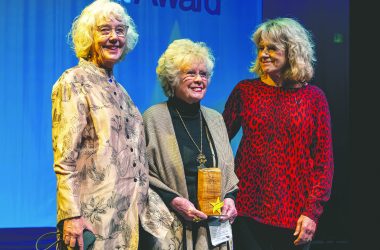 The Village Green closes its doors this week, and will transform under new ownership.
The Village Green closes its doors this week, and will transform under new ownership.
Editor’s note: First of a three-part series.
COTTAGE GROVE – The current incarnation of the Village Green closes operations Friday as a new owner assumes control of the property. To help dispel rumors of what is to happen with this 61-year-old resort, The Cottage Grove Area Chamber of Commerce shared a statement form the new owners.
It acknowledges changes are coming, but that many options are on the table. “We are excited about creating a vibrant, mixed-use development that supports the local economy and provides new housing,” said Colin Kelley of Timberview Construction. (You can read the entire statement on the Chamber’s Facebook page).
This is the first of a three-part look at the life, business adventures, and past and continuing contributions to Cottage Grove by a true mechanical genius, Walter “W. A.” Woodard.
Coinciding with the bittersweet ending of his last major venture, this week I’m sharing some hopefully untold details of Woodard’s creation of the resort.
Although he possessed only a 3rd-grade education, W.A. had a rare eye for seeing opportunities others missed or didn’t have the guts to take on. He would study a situation carefully before making a move. For areas outside his expertise he enlisted trusted experts and only got involved in decision-making if he felt things weren’t going well.
In 1957 Woodard’s Latham Mill was sold to Weyerhaeuser Corporation, bringing in a tidy sum. When asked “Why did he let go of his mill?” grandson Casey Woodard answered, “He was getting some age on him and market demand was such that the rotation of W.A.’s timber holdings was not sufficient to supply the mill, but primarily he was more of a builder and a creator than a manager. There just wasn’t the challenge for him in managing a well-running enterprise. He wanted to do something else.”
The idea of building a hotel was already in his mind for a piece of property Woodard owned along Highway 99, when he got word of the new interstate system’s I-5. Acting on his instincts and sensing the advantages of interstate travel, Woodard purchased 30 acres near the future interchange. Six acres of this parcel became the Village Green Resort but much of the remainder was donated to become the Cottage Grove Airport.
Even this was part of Woodard’s vision. Anywhere he went, W.A. absorbed ideas. He ran across a fly-in hotel in Palm Springs that prompted him to push the airport’s development. To this day there are guests who fly their planes to Cottage Grove and walk across to their lodgings.
Starting in 1971, The Green was home to a more mundane mode of travel serving as the station for “The Goose,” O.P. & E. Railway’s excursion train. There was also a railroad museum housed in historic railway cars and some unique engines besides the one that pulled the tourist train. Poor track conditions, declining ridership, and unaffordable insurance rates silenced the Goose’s steam whistle in 1988.
Often described as a “Monument to Wood,” the Village Green was certainly built primarily of forest products as well as being bankrolled by a fortune wrested from the woods the hard way. A reviewer in the timber industry publication “Crow’s Lumber Digest” gushed about the innovative use of wood. “At Cottage Grove, Ore., Woodard Hotels, Inc. have built a showcase for wood construction, known as the Village Green motor hotel. The builders, lifelong Oregon Lumbermen, have endeavored to show that wood products can be used to advantage even in the finest of structures.”
“Native Hemlock tongue & groove paneling, Douglas Fir beams (massive ones exposed in the Fireside Lounge are 6” x 16”), hand split Cedar shakes, turned Redwood tables, and extensive fencing and wooden exteriors” were glowingly recounted in the article. “Where other materials (not wood) are used, it is obvious that natural materials such as brick, stone, and tile were stressed, with manmade materials such as aluminum and plastics not much in evidence.”
Some of the more impressive wood features – such as the laminated spiral staircase – have been eliminated or altered, but stonework fireplaces, and prominent wooden covered walkways still attest to the care that went into building the Green. Gov. Mark Hatfield, who famously opened the resort by chainsawing through a Douglas Fir log, remarked that “Wood products need not take a back seat to any material in the field of modern architecture.”
 Top: The legendary laminated spiral staircase, removed during a remodeling initiative after an ownership change.Photo from Crow’s Lumber Digest, Aug. 25, 1960 issue
Top: The legendary laminated spiral staircase, removed during a remodeling initiative after an ownership change.Photo from Crow’s Lumber Digest, Aug. 25, 1960 issue
 Left: Gov. Mark Hatfield wields a chainsaw to open the Village Green (as opposed to a ribbon cutting) on July 16, 1960.
Left: Gov. Mark Hatfield wields a chainsaw to open the Village Green (as opposed to a ribbon cutting) on July 16, 1960.
Wood, while durable, does require maintenance. Most of the cedar shake roofs have been replaced and remodels by a succession of new owners since the Woodards sold the Green in 1986 have eliminated or covered over many of the original award-winning design features. Even with its star dimmed, the Village Green has a quiet charm. A look back at 1960 prices: $8 for the economy room up to $35 for the two-bedroom living room suite, a bit different from today!
A nostalgic crowd filled the Green to capacity on its last weekend. One of the staff described a couple who had stayed here for their honeymoon and faithfully have returned for each of their 45 years of marriage, staying in the same room. “The wife was heartbroken when they found out we are closing. They came early since we will be closed by their October 15 anniversary, but it wasn’t the same. They like to drive around the area and see the fall leaves and it’s too early. They don’t know what they will do in the future. She was crying and it made me cry for them too.”
On local social media there was an outpouring of memories, people remembering special events, graduation parties, weddings, and a place they could recommend to out-of-town guests. One writer called the resort “The Walmart of its day, half the town worked there at one time or another.” There was a fair amount of back and forth about the merits of replacing at least part of the complex with housing. Also some pushback to demands that the Village Green be saved. “It’s the property owners’ decision” and “Where were you when the parking lot was near-empty?”
 Below: The famous “Iron Maiden” – another iconic feature at The Green.
Below: The famous “Iron Maiden” – another iconic feature at The Green.
Casey Woodard’s take on the closing was more practical. “As all things change, so has travel. Jets have replaced the car for many long trips. The Village Green was halfway from San Francisco to Seattle, so it was an ideal stopping place in its time. The size of it was not conducive to larger conventions and while it was profitable when my family had it, it was never a barnburner. That led my father, Carlton Woodard, and both brothers, Kim and Kris Woodard, to build the Valley River Inn, Eugene, in 1973, and to sell the Village Green in 1986. The Getty’s didn’t really maintain it very well and led to the decline in its condition.”
As we wait for the plans to unfold for what happens with the Village Green, its many fans are reliving memories and thinking wistfully of pleasant times spent there. Thank you, Village Green, it’s going to take some getting used to, whatever comes next.
Next week: The Woodard Family Foundation and its good works.
Email: [email protected]








